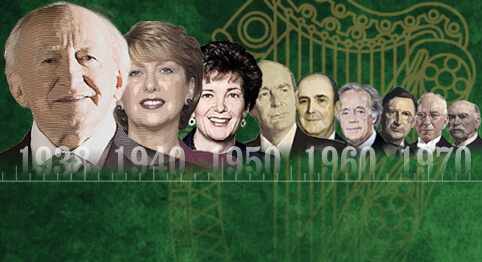

The role of the President of Ireland has evolved since its establishment in 1938, reflecting the nation’s growth and transformation on the global stage. The Presidents of Ireland serve as symbolic leaders, champions of the Irish people, and custodians of its rich cultural heritage. With each presidency, the office has taken on new dimensions, from fostering unity to promoting Ireland’s place in the world.
In this blog, we will explore the fascinating history of Ireland’s presidents, answer key questions about the role, and examine its significance in shaping the identity of modern Ireland.
Who Are the Nine Presidents of Ireland?
The Presidents of Ireland in order, starting with the office’s inception, are:
- Douglas Hyde (1938–1945)
Ireland’s first president and a Protestant, Hyde was a celebrated scholar of the Irish language and culture. His presidency set the tone for a non-partisan and unifying role. - Seán T. O’Kelly (1945–1959)
O’Kelly served two terms and oversaw a period of significant economic and social change in post-war Ireland. - Éamon de Valera (1959–1973)
One of Ireland’s most influential political figures, de Valera brought decades of revolutionary and governmental experience to the presidency. - Erskine H. Childers (1973–1974)
Known for his statesmanship, Childers tragically died in office, making him the only Irish president to do so. - Cearbhall Ó Dálaigh (1974–1976)
A former Chief Justice, Ó Dálaigh’s presidency was marked by his legal expertise, though it ended abruptly with his resignation. - Patrick Hillery (1976–1990)
Hillery was a unifying and apolitical president, serving two terms and focusing on stability during his tenure. - Mary Robinson (1990–1997)
The first female president of Ireland, Robinson modernized the office, emphasizing human rights, equality, and Ireland’s global reputation. - Mary McAleese (1997–2011)
Another groundbreaking leader, McAleese was the first president from Northern Ireland, focusing on reconciliation and cross-border unity. - Michael D. Higgins (2011–present)
A poet, academic, and advocate for equality and environmental issues, Higgins has served with distinction for over a decade.
Who Has Been President of Ireland?
Ireland’s presidents have come from diverse backgrounds, showcasing the country’s evolving political and social landscape. They include:
- Revolutionary leaders like Éamon de Valera.
- Scholars like Douglas Hyde.
- Trailblazing women like Mary Robinson and Mary McAleese.
- Visionary thinkers like Michael D. Higgins.
Each president has brought their unique perspective and focus to the role, shaping its impact on Irish society and beyond.
Who Was the President After Mary Robinson?
After Mary Robinson’s transformative presidency, Mary McAleese succeeded her in 1997. McAleese’s tenure was marked by efforts to build bridges between communities, particularly in the context of Northern Ireland and the peace process.
Which Irish President Died in Office?
Erskine H. Childers, the fourth president of Ireland, passed away in office in 1974. His sudden death during his first term was a moment of national mourning and a testament to his dedication to public service.
Understanding the Role of the President in Ireland
Does Ireland Have a President or Prime Minister?
Ireland has both.
- The President of Ireland is the head of state and holds a largely ceremonial role, representing the nation at home and abroad.
- The Taoiseach (Prime Minister) is the head of government, responsible for the country’s executive functions and decision-making.
How Long Is a Presidential Term in Ireland?
A presidential term in Ireland lasts seven years, with the possibility of serving two terms. For example, Michael D. Higgins, first elected in 2011, is currently serving his second term.
How Long Has Michael D. Higgins Been President of Ireland?
As of now, Michael D. Higgins has been president for over 12 years, making him one of the longest-serving Irish presidents.
Intriguing Aspects of Ireland’s Presidency
Protestant Presidents of Ireland
Ireland’s first president, Douglas Hyde, was a Protestant. His election was a powerful symbol of inclusivity in a predominantly Catholic nation.
Ireland President Half-Indian
While no Irish president has been of mixed heritage, there have been significant discussions about diversity in the presidency, reflecting Ireland’s increasingly multicultural society.
First Irish President of USA
Though unrelated to Ireland’s presidency, it’s worth noting that John F. Kennedy, the first Irish-American president of the United States, is a source of pride for Ireland due to his strong ancestral ties to the country.
FAQs About Ireland’s Presidency
1. How Is the President of Ireland Elected?
The president is elected by the people of Ireland through a direct vote. If there’s only one candidate, they are declared president without a vote.
2. What Powers Does the President Have?
The president’s powers are largely ceremonial, including signing bills into law, representing Ireland internationally, and acting as a guardian of the constitution.
3. Can the President Refuse to Sign a Bill?
Yes, but only under specific circumstances. The president can refer a bill to the Supreme Court to determine its constitutionality.
Ireland’s Presidents: A Reflection of a Nation
From cultural icons like Douglas Hyde to global ambassadors like Mary Robinson and Michael D. Higgins, the Presidents of Ireland have reflected the country’s values, aspirations, and evolving identity. Their contributions go beyond the ceremonial—they embody Ireland’s resilience, progress, and hope for the future.
Explore More About Ireland’s Heritage
For more insights into Ireland’s fascinating history and culture, visit Secret Ireland. Dive into related articles:
- Leinster Region in the Republic of Ireland
- Irish Stew: A Timeless Taste of Ireland’s Heart
- The Best Irish Soda Bread Recipes: A Taste of Ireland’s Heart and Hearth
Celebrate the rich history and leadership of Ireland through its presidents, each one a chapter in the story of this remarkable nation. Sláinte!



